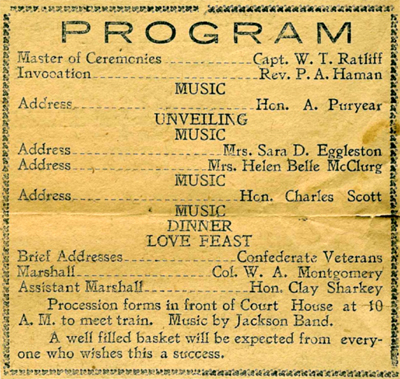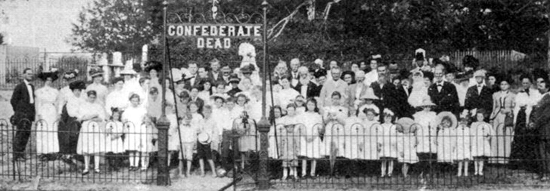|
142nd Anniversary of the Battle of Raymond By
May 12, 2005, marks the 142nd anniversary of the Battle of Raymond, an event once labeled as “the saddest day ever in the history of Raymond.” Citizens were not prepared for the horrors of war as blue met gray along the banks of Fourteenmile Creek, one mile west of town. By day’s end, the battlefield was blanketed with soldiers who had lost their lives during the six-hour engagement. Late that afternoon, as the heat of the day engulfed the soldiers, General John Gregg, commander of Gregg’s Brigade, recognized that the Confederate brigade was severely outnumbered and that his only option was to retire from the field. Before retreating, he sent a courier over to General James McPherson of the Union Army, asking for a truce to bury the dead. McPherson, a young and inexperienced general, denied the request and Gregg was forced to retreat, leaving his dead and wounded where they fell.
In the years following the battle, the Raymond chapter of the Daughters of the Confederacy worked diligently to remember and honor those who lost their lives. In 1908, on the 45th anniversary of the Battle of Raymond, two thousand guests visited Raymond to attend the dedication of the Confederate Monument erected on the courthouse grounds. In conjunction with the dedication ceremony an article appeared in the Hinds County Gazette: “Last Tuesday May 12th was the anniversary of the battle of Raymond…The Confederate forces engaged at Raymond consisted of Gregg’s Brigade of Tennesseeans and Kentuckians [and Texans] which opposed the advance guard of Grant’s army, the only object being to harass them and retard their march toward Vicksburg. Several hundred were killed on each side. The graves of the northern dead have long ago been gathered up and buried in the nation’s beautiful cemetery. [Vicksburg Military Park] Their graves are marked with slabs of marble and over them floats their country’s flag. “A few only of the dead of the Lost Cause sleep in the old [Raymond] cemetery; most of them lie in unknown graves where they fell on the battlefield. They have no government to honor their memory and mark their last resting place for the nation on whose altar they died, lives only in history and in their hearts of those who fought beneath her sacred banner; but history shall be their monument and in ages that are to come, when bronze shall have perished and marble returned to dust, men will read their records, admire their gallant deeds and applaud their heroic deaths.” Two years later, in 1910, the women of Raymond pushed forward with the dedication of the Confederate Cemetery. The pride and joy of the cemetery was the iron paling and gate erected around the hallowed ground to enclose the soldiers At Rest. Sarah Dabney Eggleston, daughter of Thomas Dabney, planter, and wife of John Eggleston, Confederate Naval hero, wrote an article for the Hinds County Gazette honoring the dead: “We have chosen May the 12th as our Memorial Day, it being the anniversary of the battle of Raymond. On May 12, 1863, Gen. Gregg with 2000 men withstood for several hours Logan’s Corps of ten times that number. Our force was compelled to retreat and Raymond fell to the hands of the invaders. The dead of that memorable day now sleep in our soldiers’ cemetery. It is our sad privilege as well as our sacred duty to meet on the 12th of May every year and scatter flowers over the graves of our dead heroes.” In the years following World War I and World War II, the citizens of Raymond continued to care for the soldiers At Rest on the hillside facing the battlefield where they fell so many years ago. In 1987, the majority of the headstones to the Unknown Soldier were removed and replaced with Confederate stones stating the names and regiments of the 115 known dead, including 66 Tennesseeans and 41 Texans whose regiments bore the brunt of the battle. Today, Raymond is recognized as one of the loveliest and most historic towns in Mississippi. Tourists come from all across the United States to view the Civil War treasures: the battlefield across the banks of Fourteenmile Creek; the historic courthouse that served as a Confederate hospital; St. Mark’s Episcopal Church that served as a Union hospital; Grant’s headquarters at Waverly; the lovely antebellum homes; and the Confederate Cemetery on a hill far away where so many died “far away from home.” As citizens of Raymond mark the 142nd anniversary of the Battle of Raymond, it is comforting to recall the poem of William Dunbar who wrote a loving tribute to the fallen soldiers: “Oh ye, in silent comradeship asleep, In the long bivouac of the martyred dead, Ye are not yet forgotten - nor can be, While in this fair magnolia land there blooms a fragrant flower with which to deck your graves.”
*Historic source: 1908 and 1910 Hinds County Gazette newspaper clippings from the Gillespie Collection. The poem, Our Battle Abbey, was written by William Forman Dunbar, owner of Wakefield Plantation in Adams County. |

